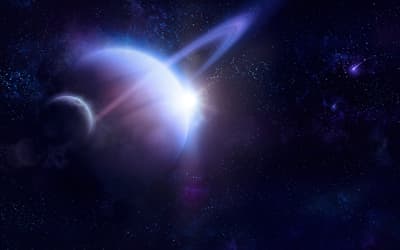Research conducted by Answers in Genesis staff scientists or sponsored by Answers in Genesis is funded solely by supporters’ donations.
Abstract
I identify a little-noticed issue in the normal formulation of the light travel time problem. In addition, I lay groundwork for the beginning of a new solution to the problem. This solution invokes similarity between creative acts of Day Four and other days of the Creation Week, but especially Day Three. The Day Three account suggests unusually fast growth for plants. In similar fashion, this possible new solution suggests unusually fast propagation of light on Day Four, probably by rapid expansion of space. This is an appeal to a miraculous event rather than a physical process to get distant starlight to the earth. It is not yet clear whether this suggestion could have testable predictions. If this is the correct way to look at the problem, it may be that we are seeing much of the universe in something close to real time. I briefly compare this possible solution to the light travel time to other previously published proposals.
Keywords: Light travel time problem, distant starlight
Introduction
The light travel time problem is one of the greatest challenges that recent creationists face today. Simply defined, if the universe is only thousands of years old as the Bible strongly suggests, then how can we see objects that are at light travel time distances far greater than a few thousand years? A popular unit of distance used in astronomy is the light year, the distance that light travels in a year. Multiplying the speed of light by the number of seconds in a year, we find that the light year is a little more than 9 × 1012 km. Obviously, using “normal” units of distance measurements such as meters or kilometers is woefully inadequate in astronomy, hence the definition of this new unit of distance. With the most straightforward approach to the biblical record and the vast distances in astronomy, we ought not to see any objects more than a few thousand light years away. Most of the objects visible to the naked eye are not this far away, so, as the light travel time problem normally is defined, most objects visible to the naked eye do not present a problem to the recent creation model.
However, there are two important points that we ought to consider. First, astronomers think that a few faint objects visible to the naked eye are much farther away than a few thousand light years. For instance, M31, the Andromeda Galaxy, the most distant object normally visible to the naked eye, is about two million light years away. Furthermore, since the invention of the telescope four centuries ago, astronomers have discovered many more other galaxies and objects much farther away than a few thousand light years. Most notable are quasars, which according to most estimates, are billions of light years away. If the world is only thousands of light years old, none of these very distant objects ought to be visible.
A second important point is that by concentrating upon the very distant objects, the light travel time problem is not formulated properly, for the situation is far worse! Most treatments of the light travel time problem concentrate upon the question of how we can see objects more than 6,000 lt-yr away. Because most objects clearly visible to the naked eye are well within 6,000 lt-yr, they aren’t a problem in a recent creation. But while it is possible for us to see most of the naked eye stars and today, some millennia after the Creation Week, it would not have been possible for Adam to have seen any stars (other than the sun) for at least four years after his creation. The stars were made on Day Four, and Adam was made on Day Six. The nearest star after the sun is 4.3 lt-yr away, so Adam could not have seen even the closest star for more than four years, and then stars would have slowly winked in over the succeeding years. However, the stars could not have fulfilled their God ordained functions when Adam first saw them after Day Six. These functions include being used to mark seasons and the passage of time (we still do this today with the day, month, and year). The passage of the year and the seasons are reckoned by how the sun appears to move against the background stars as the earth orbits the sun. Absent these background stars, it would not be possible to determine the passage of the year and of the seasons. Therefore, to truly solve the light travel time problem, light from stars even a few light years away must have been visible only days after their creation (and it is likely that the light of all the astronomical objects reaching the earth today also reached the earth at this early time). Any realistic solution to the light travel time problem must explain how Adam could have seen any stars on the evening following Day Six. Once that issue is resolved, the light travel time problem for truly distant objects probably is solved as well. At any rate, we ought to properly formulate the light travel time problem in all discussions of this issue.
Previous Solutions to the Problem
At least seven distinct kinds of solutions for the light travel time problem have been proposed in the creation literature. We will not discuss them in much detail here, for this has already been done in various places. Instead, we will merely list them in the roughly chronological order in which they have been proposed, followed by the briefest of discussion. They are:
- Question the distances
- Light created in transit as part of a fully functioning universe
- Light follows some peculiar non-Euclidean space so that light from the entire universe can arrive in just a few years, regardless of great distance
- A decrease in the speed of light, allowing for light from the entire universe to reach the earth very quickly, within the Creation Week
- Biosphere model, or, as some critics of this model call it, the soft gap
- Cosmological models using general relativistic effects to get light to reach the earth very quickly during the Creation Week.
- Time convention
Few creationists have aggressively pursued solution one. The reasoning for this solution has been that if the distances of astronomical objects are not known that well, then astronomical bodies may be far closer than generally thought, and hence there is no light travel time problem. This solution amounts to defining the problem away, but there are additional problems with this solution. First, creationists who have suggested this solution do correctly point out that trigonometric parallax, the only direct method of measuring stellar distances, yields distances that at most are only a few hundred light years. So this could explain why we see all the stars for which we have directly determined distances. One might further reason that since the distance determination methods that give very great distances that cause the light travel time problem today are indirect, those indirect methods are somehow suspect. However, one cannot dismiss the indirect methods so easily. Most of these methods are based upon well understood physical principles, and many of the indirect methods are calibrated to trigonometric parallax. See Faulkner (2013) for a discussion of distance determination methods. Second, this solution relies upon the incorrectly formulated light travel time problem. While today we can see stars such as Alpha Centauri, the closest star similar to the sun, with this solution it would not have been visible to Adam at the conclusion of the Creation Week, because it is 4.3 light years away. For this solution to work, even the well determined trigonometric parallax method must be abandoned, but this is not physically supported.
For a long time, solution two was very popular, and while it is less popular today, it continues to have a wide following (the late Henry M. Morris, Jr. was fond of this solution). Proponents argue that by its very nature, creation must include some “appearance of age,” for plants, animals, and people were not made as embryos or infants, but as mature adults, even though they did not go through the normal process of growth to reach adulthood. We certainly see this is true of Adam and Eve, but it also would seem to be true of plants, or else they could not fulfill their God ordained purpose of providing food only 2–3 days after they appeared if they were not mature (Genesis 1:29–30). Similar reasoning applies to many animals. Thus, the stars could not fulfill their purposes unless they were visible right away, so God made them with their light already en route to earth. This has a certain amount of appeal to it, but it also could be construed as deceptive on the part of God to make light containing tremendous amount of information of physical processes that never happened. Since the vast majority of the universe is more than a few thousand light years distant, it would seem that we will never see light that actually left these distant objects, and hence much of the universe amounts to an illusion. This concern has been the primary motivation of those seeking other solutions to the light travel time problem.
The third solution is not much discussed anymore. It relied upon some speculative hypothesis about the nature of light that has never been demonstrated. Very few creationists embraced this solution anyway, and those who once did mention this solution normally offered it as a hypothetical possibility not necessarily with endorsement. For a critical discussion of this theory, please see Akridge (1984).
The fourth solution is that the speed of light has decreased since creation week (Norman and Setterfield 1987; Setterfield 1989). This is often called “cdk” for “c decay,” where “c” is the letter that physicists usually use to represent the speed of light. Undoubtedly, this solution has sparked the hottest debate amongst recent creationists. When the possibility that light might have decreased was first proposed in the creation literature three decades ago, it was immediately met with great interest. However, much of the early interest soon turned to opposition. Opponents do not believe that the data adequately support this hypothesis; supporters do. Opponents point out that any significant change in the speed of light would alter the structure of matter that ought to be visible in distant objects. Supporters agree, but argue that other factors have changed to compensate for this. There is a great divide on this solution, and we will not discuss this controversy anymore here.
The fifth solution, the biosphere model, proposes that the Creation Week applied to the biosphere of the earth, but that the earth itself, and the rest of the universe, are much older (Gray 2005). In this view, God made the stars prior to Day Four (even billions of years prior), but the stars did not become visible upon the surface of the earth until Day Four, for the earth’s atmosphere was opaque up to that point. This is very similar to the reasoning of day-age theorists with regards to the meaning of the Day Four account. However, we ought to point out that, unlike the dayage theory, the Creation Week of the biosphere model is a normal six day week. This solution has met with much opposition among recent creationists.
The first solution of type number six is the white hole cosmology (Humphreys 1994). The white hole cosmology posits that God initially made the universe as a white hole with the earth somewhere near the center of the white hole. The white hole eventually evaporated and ceased to exist during the Creation Week, probably on Day Four. Relativistic time dilation near the event horizon of the white hole allowed for great periods of time to pass elsewhere in much of the universe while only days elapsed on and near the earth. The much greater time elsewhere would allow light from the most distant portions of the universe to reach the earth in just days. Hartnett (2003) has pursued a somewhat similar yet very different solution by using a modified metric for general relativity. This metric has an additional dimension (for a total of five). He has acquired some very interesting results when applied to large structures, such as galaxies and quasars, suggesting that today we are seeing these objects in their infancy, despite their tremendous distances and consequent light travel times. The general relativity solutions have gained much following, but admittedly many supporters do not fully understand the sophisticated mathematics involved.
Solution number seven invokes common time conventions in astronomy (Newton 2001; Lisle 2010). In 1987, astronomers observed a supernova in a small, nearby galaxy, the Large Magellanic Cloud (LMC), so we say that the supernova happened in 1987 (the name, “SN 1987A,” says as much). However, this was when we first saw the light from the supernova, but since the Large Magellanic Cloud is roughly 170,000 lt-yr away, we can say that the supernova actually happened 170,000 years ago. Thus, astronomers have two time conventions as to when something happened, when it actually happened, and when it is observable on earth. In the time convention solution, God made objects in the universe on Day Four, but the one-way infinite speed of light caused their light to reach earth instantly. It is amazing to me that this very interesting solution has not received more attention, particularly of the negative type.
A New Proposal
I spent more than 30 years looking for a solution to the light travel time problem, and recently I began thinking about a possibility that I find satisfactory. With so many other proposed solutions, one may legitimately ask why one more? I see that most of these solutions to the light travel time problem have advantages and disadvantages. If there were one solution that worked, there would not be so many solutions, and there would not be such sharp disagreement. Please consider my modest proposal. As I have previously argued (Faulkner 1999), I submit that God’s work of making the astronomical bodies on Day Four involved an act not of creating them ex nihilo, but rather of forming them from previously-created material, namely, material created on Day One. As a part of God’s formative work, light from the astronomical bodies was miraculously made to “shoot” its way to the earth at an abnormally accelerated rate in order to fulfill their function of serving to indicate signs, seasons, days, and years. I emphasize that my proposal differs from cdk in that no physical mechanism is invoked, it is likely space itself that has rapidly moved, and that the speed of light since Creation Week has been what is today.
This understanding does no violence to the meaning of other Hebrew verbs used to describe the formation of the stars. For instance, the word בָּרָא (bārā’; “to create”), which appears only with God as its agent (cf. Koehler and Baumgartner 2001, p. 153), is used in reference to the creation of the universe generally in Genesis 1:1, the creation of the stars in Isaiah 40:26, and the creation of the heavens in Isaiah 42:5 and 45:18. In referring to God’s activity, בָּרָא often has the idea of making something totally new or of creating something out of nothing (early church fathers introduced the Latin term, ex nihilo, for the latter). However, this is not necessarily the case. The verb בָּרָא is also used of the creation of one who brings ruin in Isaiah 54:16, the creation of praise on the lips of redeemed Israel in Isaiah 57:19, and the creation of the Ammonites in Ezekiel 21:30. There is therefore no clear lexical data to suggest that בָּרָא may not be used to speak of a creative act involving the use of already-existent material, provided that God is the agent of that creative act.
Even more significantly, the word עָשָׂה (‘āśâ; “to do,” “to make”) is used specifically of the creation of the astronomical bodies in Genesis 1:16. The meaning of this verb is broader, semantically speaking, than בָּרָא, and may refer to acts of creative ingenuity by agents other than God. That being said, it is indisputably evident that עָשָׂה is commonly used to refer to the act of fashioning something out of already-existing material (for example, the creation of man in Genesis 1:26; cf. 2:7). Granted, such is not always the intended meaning, even with respect to the astronomical bodies (for example, compare Genesis 1:1 with 2 Kings 19:15; Isaiah 37:16; 66:22; Jeremiah 32:17). However, the use of עָשָׂה in the Day Four creation record apart from any contextual clues to suggest that it must bear the sense of creation out of nothing suggests that there is a distinct possibility that the making of the astronomical bodies was instead a matter of fashioning them from material previously created on Day One. Just as the description of the earth in Genesis 1:2 is of something unfinished that God returned over the next several days to shape and prepare, perhaps the matter that would become the astronomical bodies was created on Day One but was shaped on Day Four, whereupon God brought forth their light to the earth.
In order to more adequately grasp my proposal, it is instructive to examine God’s activities on the other days of the Creation Week to perhaps gain insight into patterns that might be useful to explore on Day Four. Of particular interest is the creation of plants on Day Three. In the New King James Version, verse 11 states,
Then God said, “Let the earth bring forth grass, the herb that yields seed, and the fruit tree that yields fruit according to its kind, whose seed is in itself, on the earth”; and it was so.
Verse 12 goes on to state:
And the earth brought forth grass, the herb that yields seed according to its kind, and the tree that yields fruit, whose seed is in itself according to its kind. And God saw that it was good.
Here, God issues a command that the earth “bring forth” and then the earth, in obedience, “brought forth.” Genesis 1:11 employs the hiphil stem of דש֗א (dš’), which is used to express causative action with an active voice. The King James Version fittingly translates this as, “Let . . . bring forth.” The New American Standard Bible renders it similarly, “Let . . . sprout.” Lexically speaking, דש֗א does not indicate anything about how the earth brought forth plants; however, contextual clues indicate that the use of דש֗א in Genesis 1:11 involves a rapid-growth process. That is, on Day Three, plants did not instantly appear. Instead, plants grew up to become mature. It is clear from the blessing that God saw that it was good (v. 12b) and the immediate closure of the Third Day (v. 13) that this was not the usually slow processes that we see today in plants, but rather it was an abnormally very rapid growth and development of plants. At the very least, the plants (including trees with fruit) had to have mature fruit by Days Five and Six, for animals and people made then required them for food, which God ordained for them (vv. 29–30). It is very easy to imagine this very rapid Day Three sprouting and growing to maturity of plants as resembling a timelapse movie of plant growth today.
Could this abnormally fast growth and development of plants on Day Three be anything like the pattern of making the astronomical bodies on Day Four? In my previous work on Day Four creation (Faulkner 1999), I had suggested such a rapid process, albeit without drawing the parallel to the creation of plants. The Day Three parallel can be very useful in solving the light travel time problem. The reason that plants made on Day Three could not develop at the rate that they normally do today is that they could not have performed their function of providing food on Days Five and Six. The quickest developing fruit require weeks or months, and trees require years to do this. In a similar manner, the stars could not fulfill their functions of marking seasons and days and years (v. 14) unless they were visible by Day Six. I propose that the light had to abnormally “grow” or “shoot” its way to the earth to fulfill this function. Notice that this is not the result of some natural process any more than the shooting up of plants on Day Three was. Instead, this is a miraculous, abnormally fast process. Rather than light moving very quickly, I suggest that it was space itself that did the moving, carrying light along with it.
This understanding is consistent with the concept of the stretching (נטה; nṭh) or the spreading out (מתח; mtḥ) of the heavens found in the Old Testament (for example, Job 9:8; Psalm 104:2; Isaiah 40:22; 42:5; 44:24; 45:12; 51:13). Many Christians today identify this stretching with expansion of the universe, something that I did for some time but am much more skeptical of now. There are several possible problems with this understanding. First, we often think of stretching in terms of some elastic substance such as rubber in a rubber band or a bungee cord, and this is similar to universal expansion. However, elastic stretching is not how the stretching of the heavens is described. Notice that Isaiah 40:22 likens the spreading out of the heavens as to spreading out a tent or curtain. In ancient times tents and curtains likely were made of animal skins. When stored, a tent would be rolled up, and then be unrolled to set up. Thus, the stretching was the unrolling and spreading of the tent material. Interestingly, Scripture mentions that at the end of this world, the heavens shall be rolled up like a scroll (Isaiah 34:4), the reverse of unrolling a tent or scroll. Another problem with the stretching of the heavens being universal expansion is that many of these verses seem to imply that the stretching is a past event, not an on-going stretching. Note, for example, the parallelism in Isaiah 51:13:
And you forget the Lord your Maker,
Who stretched out the heavens
And laid the foundations of the earth;
You have feared continually every day
Because of the fury of the oppressor,
When he has prepared to destroy.
And where is the fury of the oppressor?
In this verse, the statement that the Lord “stretched out the heavens” is paired with the statement that He “laid the foundations of the earth.” Since the latter act is certainly to be understood as an action completed in the past, the former should be as well. Thus, it is most likely that this past stretching is related to creation. I propose that the stretching of the heavens may refer to rapid stretching of space to get starlight to the earth on Day Four, the same day that stars were made.
Of course, it must be remembered that the aforementioned biblical references to the stretching of the heavens appear in poetic passages that are unlike the record of Day Four in Genesis 1:14–19, which bears all the markings of prose (Boyd 2005). Consequently, “stretching” in these instances may be a metaphorical device that refers to nothing more than the creation of the heavens in their expanse. In other words, the language employed is likely not specific enough to enlist as certain evidence for the defense of my view. Nevertheless, the language surely does not preclude the position I have advanced; indeed, if the text does intend to convey the idea of light travelling at an abnormally accelerated rate in order to reach the earth on Day Four (or, at the very latest, Day Six), then reference to God stretching out the heavens is quite appropriate.
This proposed solution to the light travel time problem has some similarities to some of the other solutions. Since the light is miraculously brought to the earth on Day Four, some may see a parallel to the light created in transit theory. However, the large difference is that with this new proposal, the light from distant objects actually left the distant objects that we see; in the light created in transit theory, the light that we see from very distant objects never was emitted by those objects. Some may see that this new proposal is similar to cdk, but there are at least two distinctions. First cdk follows a mathematically described decay; this new solution hypothesizes that light getting here was more of the stretching of space that commenced abruptly and ended abruptly. A second difference is that cdk relies upon physical mechanisms whereas this new proposal relies upon God’s miraculous intervention. One may see an even stronger parallel in this proposal to the white hole cosmology in that the white hole cosmology could provide the physical mechanism for the stretching to get starlight to earth. However, I wish to emphasize that I do not require a physical mechanism for this proposal.
Discussion
Admittedly, I have left much unsaid. Since my modest proposal appeals to a miracle, there may be no physical predictions and hence nothing that we can test. Still, even a miracle can leave some observable evidence. For instance, Jesus’ disciples and many others saw (and even touched) our Lord’s risen body. Many people saw other bodies healed or raised from the dead. Thousands of people ate miraculously produced fish and bread, and many tasted the wine at the marriage feast of Cana. Might my proposal yield effects that we might observe today? Perhaps. Consider light leaving a distant star shortly after its formation on Day Four. In my view the intervening space was stretched to bring the light rapidly to earth. Soon after this event, probably still on Day Four, space assumed the properties that it appears to have today. Were properties of the light, such as wavelength and frequency, altered during this process? I would suppose not. If it did, then it likely would produce an observable change of some sort.
But what of the details of the transition between the miraculous transmission of light over great distances to the relatively slow pace today, all accomplished on Day Four? Would this imply a transition region that still might be reaching the earth today? Might there be some implication for the Hubble relation, the general trend of increasing redshift with increasing distance? Alas, I do not know. These and many other questions must be addressed for my proposal to be taken seriously by fellow creation scientists. I hope that with time to reflect, discussion with others, and perhaps the work of others on my proposals may yield some insight into these and many more questions. I place this proposal before others to stimulate discussion.
Conclusion
Recent creationists believe that the universe is only thousands of years old. The universe appears to be far larger than just a few thousand light years in size, suggesting the light travel time problem. However, by concentrating on the current age of the universe, we incorrectly formulate the light travel time problem. I recommend that we properly state the problem by noting that Adam had to see much of the universe at the conclusion of the Creation Week.
Here I have presented the beginning of a new proposal of a solution to the light travel time problem. I anticipate that this appeal to a miraculous solution likely will be the greatest criticism of this proposal. As creationists, we ought not to be so resistant to believing in miracles. We might as well enquire as to the physical aspects of the virgin birth or resurrection of Jesus. Both of these events are objective reality, but both were miraculous. Creation by its very nature was a miraculous event/process. As scientists, we are so used to looking at physical mechanisms that we often want to box in the Creation Week in terms of physical/natural processes. While certain aspects of the Creation Week probably were physical and there likely are physical ramifications of creation even today, we ought to realize that there are certain things about the Creation Week that we as scientists cannot fully comprehend. I admit that I had spent more than 30 years thinking primarily in terms of a physical explanation for the light travel time problem, when the solution may be far simpler and more direct.
I ought to emphasize that one expectation of this solution to the light travel time problem is that we probably are looking at the entire universe in something close to real time, regardless of how far away individual objects may be. Exactly at what point we begin to see light from certain stars that have traveled to us in the “normal way” rather than in the Day Four miracle, I have no clue. Hopefully, further discussion along these lines may help, though, given the miraculous nature of this solution, no clear answer may be possible.
References
Akridge, G. R. 1984. The universe is bigger than 15.71 light years. Creation Research Society Quarterly 21, no. 1:18–22.
Boyd, S. W. 2005. Statistical determination of the genre in biblical Hebrew: Evidence for an historical reading of Genesis 1:1–2:3. In Radioisotopes and the age of the earth, vol. 2, ed. L. Vardiman, A. A. Snelling, and E. F. Chaffin, pp. 631–734. El Cajon, California: Institute for Creation Research.
Faulkner, D. 1999. A biblically-based cratering theory. Creation Ex Nihilo Technical Journal 13, no. 1:100–104.
Faulkner, D. R. 2013. Astronomical distance determination methods and the light travel time problem. Answers Research Journal 6:211–229. Retrieved from http://www.answersingenesis.org/articles/arj/v6/n1/astronomical-distance-light-travel-problem.
Gray, G. 2005. The age of the earth: What are the biblical limits? Washougal, Washington: Morning Star Publications.
Hartnett, J. 2003. A new cosmology: Solution to the starlight travel time problem. TJ 17, no. 2:98–102.
Humphreys, D. R. 1994. Starlight and time. Green Forest, Arkansas: Master Books.
Koehler, L. and W. Baumgartner. 2001. The Hebrew and Aramaic lexicon of the Old Testament, vol. 1. Rev. ed. Trans. and ed. M. E. J. Richardson. Leiden, The Netherlands: Brill.
Lisle, J. 2010. Anisotropic synchrony convention—A solution to the distant starlight problem. Answers Research Journal 3:191–207. Retrieved from http://www.answersingenesis.org/articles/arj/v3/n1/anisotropic-synchrony-convention.
Newton, R. 2001. Distant starlight and Genesis: Conventions of time measurement. TJ 15, no. 1:80–85.
Norman, T. and B. Setterfield. 1987. The atomic constants, light, and time. Menlo Park, California: SRI International.
Setterfield, B. 1989. The atomic constants in light of criticism. Creation Research Society Quarterly 25:190–197.












